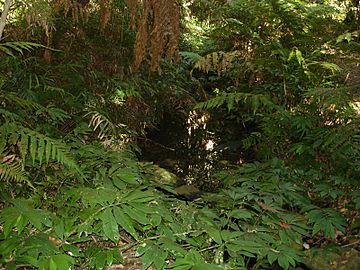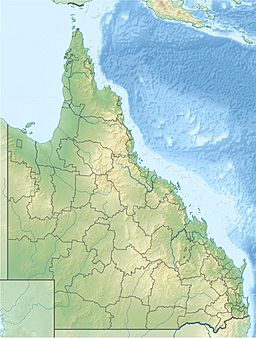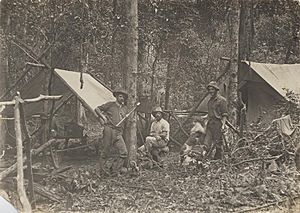Bunya Mountains facts for kids
Quick facts for kids Bunya Mountains |
|
|---|---|

A small creek in the national park
|
|
| Highest point | |
| Peak | Mount Kiangarow |
| Elevation | 1,135 m (3,724 ft) |
| Geography | |
| Country | Australia |
| State | Queensland |
| Range coordinates | 26°50′S 151°33′E / 26.833°S 151.550°E |
| Geology | |
| Age of rock | Jurassic |
| Type of rock | Shield Volcano |
The Bunya Mountains are a special group of mountains in southern Queensland, Australia. They are an isolated part of the Great Dividing Range. These mountains form the northern edge of the Darling Downs area. You can find them near the towns of Bell and Dalby. They are also south of Kingaroy and southwest of Nanango.
The Bunya Mountains are what's left of an old shield volcano. This volcano was formed by many basalt lava flows. This happened a very long time ago, about 23 to 24 million years ago. In 2009, the Bunya Mountains were named one of the "Q150 Icons" of Queensland. This was part of the Q150 celebrations, recognizing them as an important natural attraction.
Contents
What are the Bunya Mountains Like?
The Bunya Mountains are about 975 meters high on average. However, the two tallest peaks are even higher. Mount Kiangarow and Mount Mowbullan both rise to over 1,100 meters.
Rain that falls on the mountains flows in different directions. Water from the northeast slopes goes into the Burnett River. Water from the southeast slopes flows into the Brisbane River. And water from the southwest slopes joins the Condamine River. This river eventually becomes part of the large Murray-Darling River system.
Plants and Trees of the Bunya Mountains
The mountains are covered with old rainforests. These forests have special cone-bearing trees. You can also find other unique natural areas here. These include 'balds', which are open grasslands. Some of these grasslands even have rare types of grass. There are also vine forests and sclerophyll forests.
In the past, some parts of the forest were logged for timber. Trees like red cedar, bunya pine, and hoop pine were cut down. But most of the mountain peaks are still covered in forest. This is because the slopes were too steep for early timber clearers. The Bunya Mountains are home to the world's largest natural forest of Bunya pine trees.
A Special Place for Aboriginal People
The Bunya Mountains were a very important meeting place for Aboriginal people. Groups from South East Queensland, Central Queensland, and northern New South Wales would gather here. These gatherings happened when the tasty nuts of the bunya pine tree were ready. This was usually from December to March. Even bigger gatherings happened every three or four years when there was a huge crop of nuts. These were the biggest gatherings of Aboriginal people in Australia.
To get the nuts, climbers would use a strong vine around their waist and the tree. Bunya pine trees can be very wide, up to 1.5 meters, and very tall, up to 50 meters. Guest tribes were not allowed to climb the trees or collect nuts. Besides feasting on bunya nuts, people did many other things. They played games, held ceremonies, traded goods, and shared knowledge. They also arranged marriages and settled disagreements. The last known big gathering on the range was in 1902.
Today, many Aboriginal groups still have strong connections to the Bunya Mountains. These groups include the Wakka Wakka, Githabul, Kabi Kabi, Jarowair, Gooreng Gooreng, Butchella, Quandamooka, Barrangum, Yiman, and Willi Willi people. They use their traditional knowledge to help manage the Bunya Mountains National Park. The Bunya Murri Ranger project is an example of this work.
Visiting the Bunya Mountains

Most of the area is protected as the Bunya Mountains National Park. This is Queensland's second oldest National Park, created in 1908. There are many places to have a picnic and lots of walking tracks. You can also find lookouts with amazing views. There are a few camping grounds and places to stay. These include cottages and group accommodations for families, friends, and school camps.
As you walk along the tracks, you can see beautiful plants. These include ferns and staghorns, as well as the unique Bunya Pine. Waterfalls also add to the beauty of the scenery.

In the small cleared areas used by tourists, you might see colorful birds. These include Australian king parrots and rosellas. You might also spot animals like wallabies, scrub turkeys, koalas, echidnas, and possums. The special Bunya pine tree is known for its Bunya nuts. These nuts were a favorite food of local Aboriginal people.
Weather in the Mountains
The Bunya Mountains have a highland subtropical climate. This means it's much cooler and wetter than the flat lands around them. In winter, there can be heavy frosts. Sometimes, light snow even falls on the highest peaks. In summer, the mountains often have heavy storms. This rain helps the lush rainforests grow.
| Climate data for Mount Mowbullan | |||||||||||||
|---|---|---|---|---|---|---|---|---|---|---|---|---|---|
| Month | Jan | Feb | Mar | Apr | May | Jun | Jul | Aug | Sep | Oct | Nov | Dec | Year |
| Record high °C (°F) | 38.3 (100.9) |
37.7 (99.9) |
31.8 (89.2) |
27.4 (81.3) |
24.1 (75.4) |
20.7 (69.3) |
19.9 (67.8) |
24.2 (75.6) |
30.0 (86.0) |
31.8 (89.2) |
34.0 (93.2) |
36.7 (98.1) |
38.3 (100.9) |
| Mean daily maximum °C (°F) | 26.1 (79.0) |
25.7 (78.3) |
23.2 (73.8) |
19.8 (67.6) |
16.2 (61.2) |
13.1 (55.6) |
12.7 (54.9) |
13.9 (57.0) |
16.7 (62.1) |
20.5 (68.9) |
23.8 (74.8) |
25.9 (78.6) |
19.8 (67.6) |
| Mean daily minimum °C (°F) | 12.5 (54.5) |
12.3 (54.1) |
10.0 (50.0) |
7.8 (46.0) |
3.7 (38.7) |
1.9 (35.4) |
0.8 (33.4) |
1.2 (34.2) |
4.0 (39.2) |
7.6 (45.7) |
9.5 (49.1) |
11.0 (51.8) |
6.8 (44.2) |
| Record low °C (°F) | 4.8 (40.6) |
3.9 (39.0) |
1.2 (34.2) |
−2.5 (27.5) |
−4.6 (23.7) |
−7.8 (18.0) |
−9.0 (15.8) |
−6.9 (19.6) |
−6.2 (20.8) |
−5.1 (22.8) |
−2.6 (27.3) |
3.6 (38.5) |
−9.0 (15.8) |
| Average rainfall mm (inches) | 142.9 (5.63) |
125.3 (4.93) |
77.5 (3.05) |
63.9 (2.52) |
73.3 (2.89) |
49.8 (1.96) |
59.1 (2.33) |
43.0 (1.69) |
51.0 (2.01) |
84.1 (3.31) |
100.2 (3.94) |
140.5 (5.53) |
1,010.6 (39.79) |
| Average rainy days (≥ 0.2mm) | 13.9 | 13.3 | 13.5 | 10.3 | 9.8 | 9.2 | 8.0 | 7.1 | 7.0 | 8.9 | 9.9 | 12.5 | 123.4 |
| Source: Bureau of Meteorology | |||||||||||||
See also
 In Spanish: Montañas Bunya para niños
In Spanish: Montañas Bunya para niños



